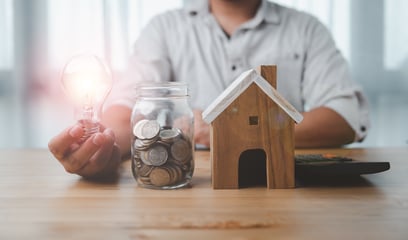 With utility costs continuing to climb while rents and unit demand are dropping, the best way to improve your bottom line is to implement a ratio utility billing system (RUBS), an inexpensive and easy way to make tenants financially responsible for their usage and incentivize conservation.
With utility costs continuing to climb while rents and unit demand are dropping, the best way to improve your bottom line is to implement a ratio utility billing system (RUBS), an inexpensive and easy way to make tenants financially responsible for their usage and incentivize conservation.
Latest stories on utility-savings
Make RUBS Part of Your Long-term Financial Investment Health Strategy
Have a Happier Financial New Year Through Conservation
2023 is here! Whether or not you set resolutions, it's natural to look for ways to improve your business at the beginning of a new year. This is a great time to think about building and bettering your properties for the sake of your business growth and development. The health of your business is everything. You can't serve tenants without a healthy bottom line.
Softening Rents, Rising Utilities: Boosting Your Bottom Line in a Tougher Housing Climate
The rental market in the US is in flux. People paying 40% of their income to rent has reached the highest number ever - the recommended proportion is 25 to 30% of income to rent. It's understandable that a market correction is coming, and it appears to be here.
In the face of rising rental prices, more states are discussing rent control measures (including hot spots like Florida and Nevada). October saw the third largest drop in rental market prices since 2010. Housing providers and residents alike are being squeezed by inflation that, while slowing, is still much higher than we've seen in recent years, causing people to stretch every paycheck further.
On top of all of that, conservation concerns and supply/demand dynamics are driving ever-increasing utility costs. From 2010 to 2019, water prices went up by about 60% for a family of four. Electricity costs have spiked recently, partially due to the current crisis in Ukraine. With winter on the horizon, those costs are expected to increase. According to a recent piece on CBS News:
"About 20% of U.S. households have missed or made a late payment on their utility bill in the last month, according to a recent Bank of America report. Not surprisingly, families with an income of $50,000 or less are struggling the most to absorb higher energy costs. Geographically, residents of Dallas and Houston are seeing some of the highest utility bill hikes this summer — up 23% when compared to the same period last year.
Higher energy prices brought on by the Russia-Ukraine war are partly to blame for the late or missed payments, BofA said. Customer utility bills rose about 16% in August compared to the same month a year ago, according to the report.
The increases are expected to continue this winter as National Grid, Con Edison and other power companies have already signaled their plan to raise prices. The average household will pay about 17% more this winter to heat their property, a 10-year high of about $1,200 per home, the National Energy Assistance Directors Association estimated earlier this month. Electric bills are also set to rise, with the U.S. residential price of electricity expected to climb 14.8 cents, a 7.5% jump from 2021, according to the U.S. Energy Information Administration."
As a housing provider, you want to do the best you can for residents but have to focus on your own bottom line as well. If you've been paying for master billed utilities, even just water, it's in your best financial interest to try to recover some of those costs, especially if you can't raise rental prices to cover them in a softening market. You could switch to individual submeters for every unit you own, but that involves pricey equipment installation - and supply chain disruptions mean it may not be an immediate solution anyway.
But there is good news! Ratio Utility Billing Systems, also known as RUBS, give you the opportunity to fairly recover up to 90% of the costs for any master billed utilities you pay in your investment properties. That can include electricity, gas, water, wifi, high-speed internet access and cable. With RUBS, you simply provide all the information about your properties and any shared amenities - the algorithms do the rest. You can fairly and accurately share the costs among your residents, based only on what they use. Not only do you recover your costs, but knowing what they are using drives residents to conserve. That's better for their wallets - and yours - and the health of the planet!
If you're not ready for RUBS (or prevented from implementing it for some reason), a Sample Statement showing residents what they WOULD pay can also drive conservation behaviors, even if they aren't spending any money directly. A study by the EPA showed that the simple act of informing people of the costs of their habits will cause them to reduce consumption by up to 15%! Bonus: What's good for your wallet is good for the planet.
"RUBS is easy to implement. It takes very little time to get started, and our enrolled housing providers start seeing recovered costs in as little as 60 days. We don't require a minimum number of units to get started, so it's ideal for those with even just 1 unit to manage," says Daniel Sharabi, CEO of Livable. "Sharing accountability for consumption among housing providers and residents helps preserve our precious natural resources at the same time, reducing use of both water and energy."
"As the rental market continues to be in upheaval, it's in the interest of housing provider to work on recovering master billed utility costs now," Sharabi explains. "Not every market has been affected by a correction yet, but it will happen. The time to get ready is now, especially for independent rental owners with a smaller number of units who don't have the resources of a major corporation behind their investments."
Reaching Younger Renters: Sustainability is Key
Baby Boomers, long the drivers of consumer culture in the United States., are no longer top of the pecking order. Millennials and Gen Z, the generation after them, have taken over! Millennials are now the largest of all living generations. Gen Z, mostly the children of the smaller Gen X, aren't far behind. And both generations are less likely to become homeowners, which makes them your target market.
Why aren't these younger generations buying homes the way their parents and grandparents did? It's partially an economy that has left them with flat wages and staggering college debt, but it's also a different set of values. Younger Millennials especially are driven more by experiences than ownership; they'd rather rent and let someone else deal with the hassles of maintenance than buy a house they have to deal with, in many cases. Buildium characterized them as a generation of "forever renters:"
"The combination of low savings rates, inflation, high interest rates, and the aversion to staying in one place permanently, is making 1 in 4 Millennials give up on home ownership. In 2018, by contrast, only 13.3% of Millennials expected to rent for the rest of their lives.
Millennials are relishing the upsides of renting too. Like the flexibility to relocate for career, travel, and family. They can upgrade proportionally to their income. It gives access to more amenities. There’s less maintenance, risk, and responsibility that comes with renting as well."
Along with that flexibility, great amenities, myriad payment options and digital-first experiences, from paperwork to payments, Millennials and Gen Z both look for places to live that align with their values. Top on that list? Sustainability. That means a lot of things, including walkability and bike access to areas around where they live.
That also includes conservation. They don't want to print anything - digitally signed leases and contracts are paramount. It's a faster way to do business that doesn't waste paper or put ink into landfills and water supplies.
They want to see things like LEED certifications, local energy efficiency grades, Energy Star-rated appliances, low flow showerheads and other sustainable features in their apartment buildings. Marketing the sustainability of your property will help attract these younger tenants, most of whom will be long term.
Some do's and don'ts when it comes to marketing your sustainability to potential residents:
- Don't make false claims. They will find out!
- Do actually pursue sustainable practices. Even if you're just getting started, taking steps toward conservation will impress younger potential tenants.
- Do remember to use social media when marketing your available residences. (NOT Facebook!)
- Do look for sustainable features you already have in place but might not think of to feature in listings and promotions. Sustainability isn't just EV charging stations or solar panels on the roof! Those things are great, but less sexy, everyday features like lower volume toilets, smart lighting, available recycling pickup and energy efficient appliances matter too.
- Do mention if you're using a Ratio Utility Billing System (RUBS) to inspire your residents to conserve through accountability and education.
Attracting younger residents who are spending more of their income on where they live makes for a better bottom line. Highlighting sustainability practices in your marketing efforts is key to reaching that audience.
It's OK to be a Scrooge with Utilities this Holiday Season!
It's the most wonderful time of the year! But all those wonderful light displays and colder temps come with a hefty price tag. A few simple changes can help trim utility bills for you and your Residents while saving both energy and water. Be sure to share this list of handy tips with everyone in your properties. What's good for the planet is good for your wallet!
Explore More Energy Savings News in the Inflation Reduction Act
Last month, we told you about the great investment incentive tax credits the Inflation Reduction Act offers investment owners of rental properties. Before the IRA was passed, those tax credits were only offered to homeowners who lived in the property they upgraded with solar, wind or other renewable energy. It's a huge new benefit for Housing Providers! But the IRA, the single largest government investment in clean energy, goes much further to promote the widespread use of renewable energy, electric vehicles and other tactics to conserve our natural resources.
The Inflation Reduction Act & Renewable Energy: How Much Can You Save?
The Inflation Reduction Act, also known as the IRA, includes great news for multifamily housing providers! While residential tax credits were available to homeowners who installed solar panels or invested in other forms of renewable energy, rental property owners were excluded from those credits unless the owner lived onsite. The IRA now offers investment Housing Providers the same credits – up to 30% of the price! – that owners who occupy housing have been able to take advantage of for years.
As temperatures continue to rise, staying cool this summer means an increase on your utility bills. While the rising heat impacts financial and environmental factors, there are habits you and your Residents can apply to your daily summer living to reduce those financial and environmental impacts. By following these simple summer energy-saving tips, you and your Residents can keep the temperature, and your budget, well within your comfort zone.

